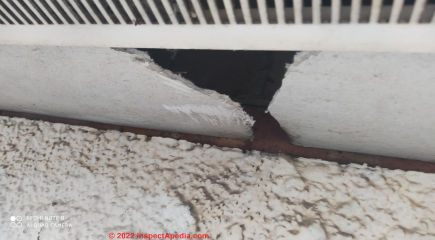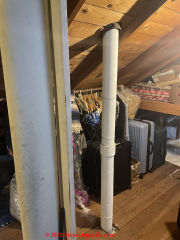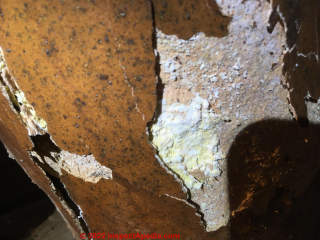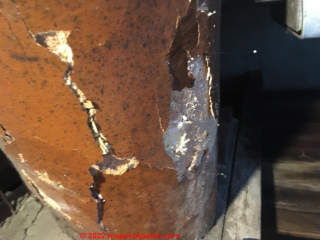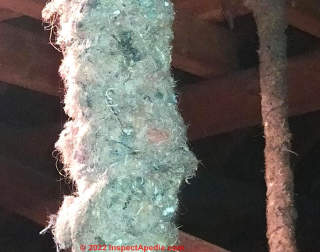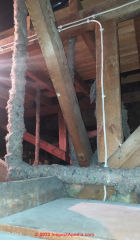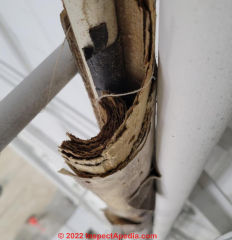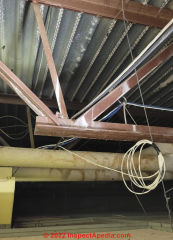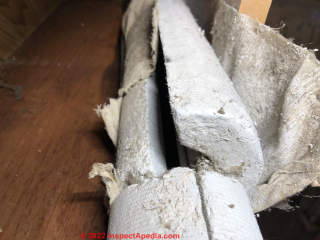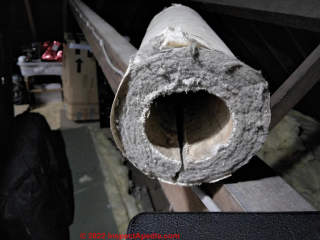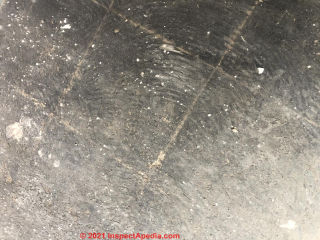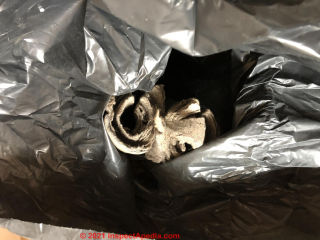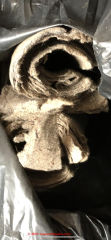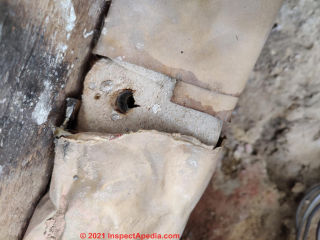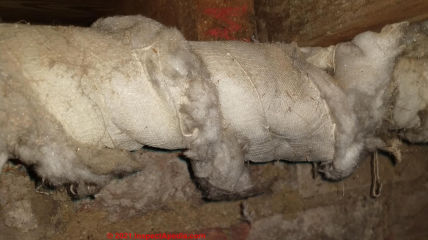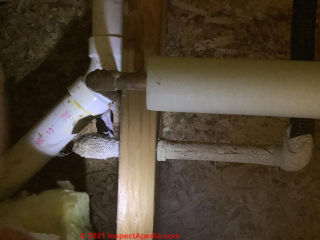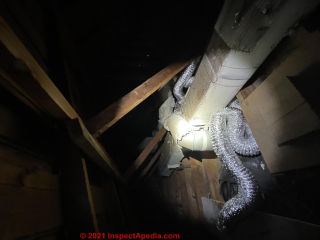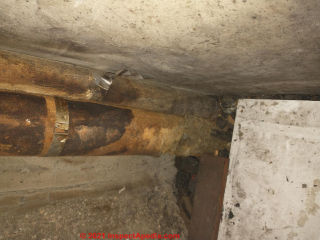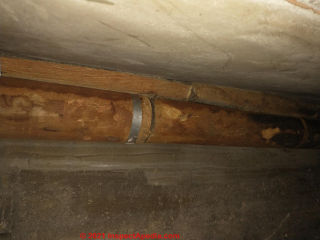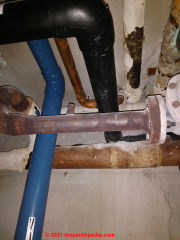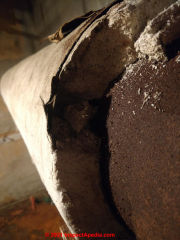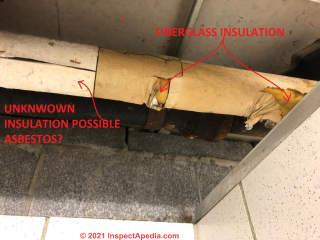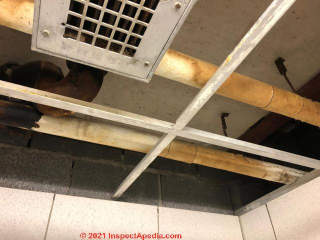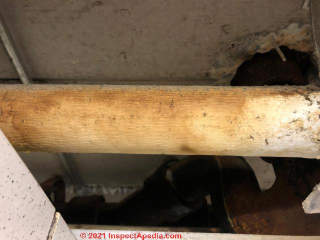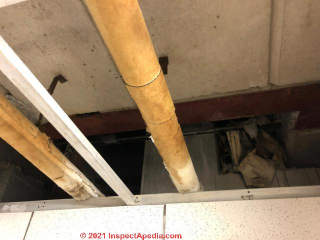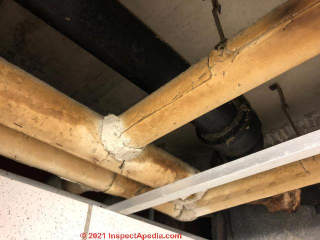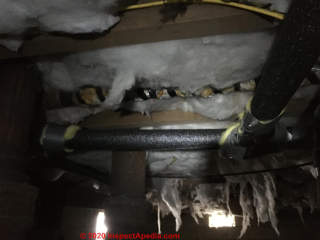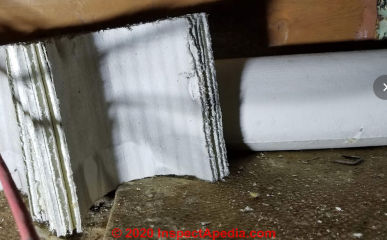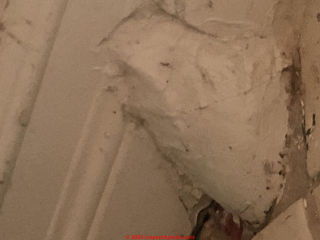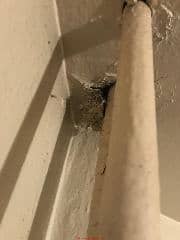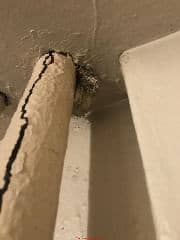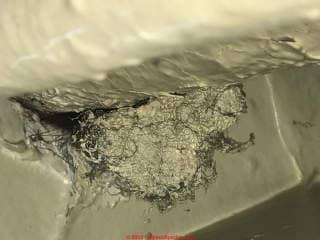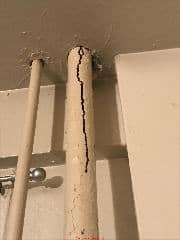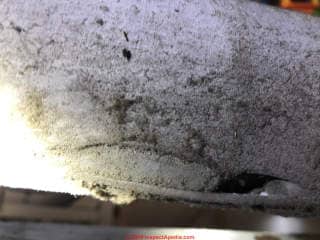 Asbestos Pipe Insulation FAQs #2
Asbestos Pipe Insulation FAQs #2
Recent FAQs on asbestos insulation on pipes: recognize & take action
- POST a QUESTION or COMMENT about asbestos-containing pipe insulation: identification, encapsulation, or removal
Q&A about asbestos pipe insulation in buildings set #2.
Recent FAQs about how to recognize asbestos insulation on heating or water pipes and what to do about it.
This article series provides photographs of abandoned and partly-covered-up asbestos pipe insulation in buildings to assist in the recognition of that material.
InspectAPedia tolerates no conflicts of interest. We have no relationship with advertisers, products, or services discussed at this website.
- Daniel Friedman, Publisher/Editor/Author - See WHO ARE WE?
Questions & answers on Asbestos pipe insulation
 These questions & answers or comments about asbestos-containing pipe insulation and asbestos pipe insulation removal and disposal procedures and costs were posted originally
These questions & answers or comments about asbestos-containing pipe insulation and asbestos pipe insulation removal and disposal procedures and costs were posted originally
at ASBESTOS PIPE INSULATION - be sure to read that article.
Watch out: asbestos pipe inslulation in good condition is usually best left alone or encapsulated: left alone, in place, undisturbed, risks and costs are minimized. But if asbestos pipe insulation is in poor condition, shedding, damaged, falling-off, or if it is in a location where it is likely to be damaged, it should be removed and the pipes cleaned and sealed.
For asbestos pipe insulation that is in poor condition, falling off it is beyond encapsulation and needs to be removed by a professional.
This article series assists building buyers, owners or inspectors who need to identify asbestos materials (or probable-asbestos) in buildings by simple visual inspection.
Photo: corrugated asbestos paper on a roof drain pipe in a commercial building.
[Click to enlarge any image]
On 2022-05-20 by InspectApedia-911 (mod) - distinguish between non-asbestos-containing fiber cement board and asbestos-cement board?
@Daniel,
If you decide to have that cement board tested for asbestos, do let us know the results, as that will assist others. Certainly if the age of the home dates (in the U.S. before 1986) the cement board is probably an asbestos product.
It's not friable. Just avoid making a dusty mess by sawing, grinding, etc.
On 2022-05-20 by Daniel
@Friedmandaniel911, thanks very much for the info. Builder thinks it was put in 20 years ago, after asbestos was stopped, but I'm not sure what his basis is for that. I might send a bit to a lab.
On 2022-05-19 by InspectApedia-911 (mod)
@Daniel,
thanks, that's a great question: can we distinguish between non-asbestos-containing fiber cement board and asbestos-cement board.
The short answer is ... it depends, or "sometimes".
IF we knew that the date of a building's construction was definitely after asbestos cement products were no longer being sold in your country
or
IF we had sales receipts for the work showing its materials-purchase-date was after asbestos cement products were no longer being sold in your country
Then you could make a reasonable guess at "not-asbestos".
OR
IF you had a lab test of a representative sample of the material that'd answer the question - FOR THAT PIECE ALONE.
I'm fussy on this point because it's absolutely the case that there were some fiber-cement products such as building siding panels that were made after asbestos was no longer being used but that look absolutely identical, otherwise, to their older sisters who contained asbestos.
So in the case of your home, if it's date of construction is from when asbestos cement board was being sold in your country AND if you have every reason to think the material in your photo is original, most-likely it contains asbestos.
On 2022-05-1 by Daniel
@Inspectapedia Com Moderator, is there a way to distinguish between fibre cement and asbestos?
On 2022-05-19 by Daniel
@Inspectapedia Com Moderator, yes the smooth white material next to the vent. The builder thinks it isn't asbestos and was put in about 20 years ago.
On 2022-05-019 by Inspectapedia Com Moderator (mod)
@Daniel Heyman,
I'm unclear what your'e asking about: that stucco-like material or the smooth, broken board (maybe fiber cement or asbestos cement?)
On 2022-05-019 by Daniel Heyman
Found this during loft conversion, it sits under the gutter around the roof. Builder thinks it was put in 25 years ago or so, but just wanted to check it's nothing nasty.
[Photo above]
On 2022-05-17 by InspectApedia-911 (mod)
@Jay,
The brown fabric looks like burlap or jute pipe wrap to me.
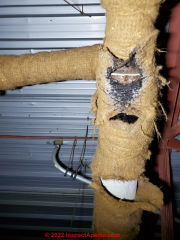
I can't say anything about that little bit of white material showing in your photo.
If you can expose the END of that white material you can compare its appearance to corrugated asbestos pipe wrap shown in the article above.
See details
at HESSIAN or JUTE PIPE INSULATION
On 2022-05-16 by Jay
Wondering if this looks like asbestos. It is on a roof drain line in a church built in 1970.
[Photo above]
On 2022-05-12 by Inspectapedia Com Moderator (mod)
@Jack,
Thanks - that plus the details we can see all argue for transite pipe used as a vent
take a look at TRANSITE ASBESTOS CHIMNEYS, DUCTS, PIPES https://inspectapedia.com/chimneys/Transite_Asbestos_Chimneys.php
On 2022-05-12 by Jack
@Inspectapedia Com Moderator, The home was built in 1951. This is located in the attic, the one on the left was for an old furnace and the round pipe on the right is the exhaust for a water heater. Property is located in San Diego CA.
On 2022-05-10 by Inspectapedia Com Moderator (mod)
@Jack,
That could be transite asbestos piping. How old is the building and where is it located?
On 2022-05-10 by Jack
Do these pipes look to be asbestos pipe?
On 2022-04-28 by Lindsey N.
@Inspectapedia Com Moderator, Thank you!
On 2022-04-28 by Inspectapedia Com Moderator (mod)
@Lindsey N.,
Fiberglass
See
INSULATION IDENTIFICATION GUIDE
https://inspectapedia.com/insulation/Insulation-Identification-Guide.php
And on that page take a look at the fiberglass insulation photos
On 2022-04-28 by Lindsey N.
Asbestos or fiberglass? Wrapped around old water pipe. House built in 1956, original pipe.
On 2022-04-20 by Inspectapedia Com Moderator - flaking off pipe insulation requires appropriate safety steps
@jprows1,
While no one can make a reliable building safety assessment based on a few photos alone, some of your photos show fine particulate debris shedding - so if that's asbestos, in any volume, you could be creating a hazardous dust needing more-extensive cleanup. And in a laundry I worry about a clothes dryer drawing hazardous dust into its air intake and through clothing.
It'd make sense to clean up using damp wiping and HEPA vacuuming. Often an expert will encapsulate or reduce particle shedding, even if only partly effective, simply by a light spray coating of a sealant paint or encapsulant (described in our Index to Related Articles).
To be clear, from what we see to this point I can't be sure even what is the material that we're seeing. I can't say if it's an insulated metal pipe or a deteriorating clay flue tile liner or something else .
On 2022-04-20 by jprows1
@Inspectapedia Com Moderator, Thanks again for getting back to me.
Assuming it is asbestos, how concerned should I be and what immediate precautions should I take while I am waiting for it to get tested. The pipe insulation is in the laundry room which we are in multiple times daily. How concerned should I be if it were asbestos?
On 2022-04-19 by Inspectapedia Com Moderator
@jprows1,
There is a reasonable chance that that material is or contains asbestos - just from its physical appearance and context of use. Experts will probably spend your money to have a sample tested - which I agree is a reasonable step.
On 2022-04-19 by jprows1
@Inspectapedia Com Moderator, @Inspectapedia Com Moderator,
Thanks so much for getting back to me. I'm not exactly sure of the age of the building. I did a quick online search and it seems like it was built anywhere between 1900 and 1930 and it is located in Princeton Junction New Jersey.
Here are more photos of the pipe from the Furnace.
One is of some of the dust that came off. I think my cat's may have disturbed it.
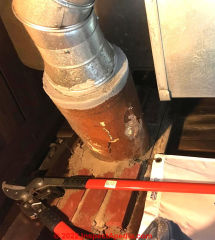 ...
... 
On 2022-04-18 by Inspectapedia Com Moderator
@jprows1,
I don't recognize that material. It's possible that it is or contains asbestos. It's also possible that there's a leak in the piping that is leaving an efflorescence salt on the surface.
You might want to have a sample tested by an asbestos lab before disturbing it. If you do that let me know what you're told us that will assist others.
We'd also welcome some other photos, and it would be useful to know the age and location of the building where this insulation is installed.
On 2022-04-18 by jprows1
Wondering what this pipe insulation could be. We are renting a house that's been up since at least the 60's and this is the insulated portion of the exhaust for our furnace. It's cracked and the inside is this yellow/white material that turns into fine powder if you touch it and roll it in your fingers. Any insight would be helpful. Thanks!
On 2022-04-07 by Inspectapedia Com Moderator - multi colored pipe wrap insulation may be recycled material
@Danielheyman123,
Thanks for the sharper photo; agreed, not likely to be asbestos from appearance, texture, strength, application, etc.
The multiple colored fragments argue for recycled rag or fabric.
On 2022-04-07 by Danielheyman123
A closer up image of the pipe insulation posted below. Many thanks for the advice. Sounds like it's not asbestos
On 2022-04-07 by Inspectapedia Com Moderator
@Daniel,
That's not a pipe insulation that I can identify with certainty.
It looks most like a pipe wrap made of recycled materials, perhaps fabrics, but possibly also some cellulose - used as a pipe lagging insulation. Typically those are made of wool or a mix of recycled wool and/or other fabric fibres.
In your photo (above) we can plainly see the edges of the wrap so we know it's a wrap-around pipe insulation, not a sleeve nor spray-on.
Recycled pipe wrap insulating fabric mix can, from a distance also look like insulation made from cellulose (wood or paper fragments) but it's not likely to be of cellulose.
See if you can get a very sharp close-up photo (you can post one photo per comment but as many comments as you need).
Look for evidence of use of chopped chopped fabric and also (unlikely) look for newsprint - tiny bit of paper with letters on them.
In the UK you may find that pipe insulation advertised as "cellulose or recycled rag or fabric pipe lagging" or as felt insulation, usually made of recycled cloth, sometimes specifically wool.
More about cellulose insulation used as a loose-fill in walls and ceilings is at
CELLULOSE LOOSE FILL INSULATION
but we direct you to our page on
SHEEPS WOOL INSULATION
where we'll include this discussion so as to invite further reader or expert comment.
Shown below are two examples of currently-available felt pipe lagging described as "Felt Insulation Hose (left in image) or as Pipe Lagging Wrap - natural wool (at right)" currently sold by online vendors.
See details at FELT PIPE INSULATION, WOOL & OTHER
On 2022-04-07 by Danielheyman123
1950s London house but had work done in 1990s. Are these pipes covered in asbestos?
On 2022-02-24 by Inspectapedia Com Moderator - Brown corrugated pipe wrap insulation may contain asbestos
@Reggie F,
Comparing your photo with the most-common form of corrugated asbestos paper pipe insulation (see page top illustration) we can see that your pipe insulation looks like corrugated paper too, but tan-brown while the photo at page top shows that pipe-wrap asbestos is usually grayish or whitish in color.
We did have a reader who reported a lab test finding asbestos in brownish color insulating wrap.
So my best advice to you is to have a sample of this material tested by a certified asbestos test lab. Please let us know the results as that will assist other readers as well.
On 2022-02-24 by Reggie F
Pipe insulation on a domestic water line. Not sure of the age. 75 percent of the room was wrapped in old glass and 1 wall had this style insulation on. All wrapped in seemingly the same cloth.
On 2022-02-18 by Inspectapedia Com Moderator
@Katie,
That might be a cloth covered asbestos insulated pipe but I can't tell from your photo. It's usually diagnostic if we can see in end of the insulation somewhere.
Take care to try not to feel sick with anxiety about this as the anxiety may be a greater health hazard.
Asbestos is safe and legal and can be left in properties when it is undamaged and undisturbed.
On 2022-02-17 by Katie
Is this asbestos wrapped pipe damaged and possibly toxic to breathe? I found it today and I feel sick over it!
On 2022-01-31 by Inspectapedia Com Moderator - possible asbestos pipe insulation
@Andy,
I'm actually not sure what that insulating material is.
You will see above on this page that traditional asbestos pipe insulation looks like a light grey corrugated paper, with a cloth exterior wrap.
An asbestos-based plaster was often used at pipe joints and elbows and sometimes as a complete covering on the exterior of boilers.
I haven't seen a cast asbestos plaster solid material used as pipe insulation so I'm not sure what your insulation is. I would not rule out asbestos.
But be sure to see and compare your pipe insulation with the products described
at MAGNESIUM CARBONATE ASBESTOS PIPE INSULATION
If you can tell us the country and city of location and the age of the building where this material is installed that would be helpful.
Meanwhile with no other information I have to err on the side of caution and tell you to treat that material is presumed to contain asbestos until you've had a sample tested.
If you do test it, let us know what you find, as that will assist others.
On 2022-01-30 by Andy
I have this around a copper water pipe in my basement. It looks like plaster with a fabric wrap. Any thoughts on asbestos?
On 2022-02-14 by Inspectapedia Com Moderator
@Steve,
Thank you, that update will assist other readers who have similar asbestos questions about insulation in their home.
In that location there is little chance of creating a detectable airborne asbestos hazard as long as the pipe insulation is left intact, undamaged, in-place.
If it must be removed then you'll want to treat it as an asbestos-containing material - proper handling, disposal, and cleaning of the exposed pipe surfaces before re-insulating.
On 2022-02-14 by Moderator: asbestos found in inner core of UK pipe insulation in 1938 Hertfordshire home
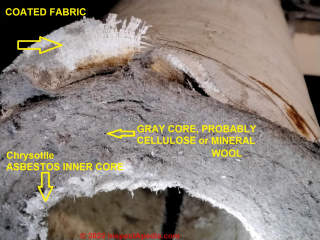 Though we can't identify the gray core in your insulation from just a photo, it looks like cellulose or mineral wool, and that outer core may simply be a coated fabric, perhaps using fiberglass or a synthetic material.
Though we can't identify the gray core in your insulation from just a photo, it looks like cellulose or mineral wool, and that outer core may simply be a coated fabric, perhaps using fiberglass or a synthetic material.
In that location there is little chance of that inner core of asbestos (asbestos paper or fabric?) creating a detectable airborne asbestos hazard in your building as long as the pipe insulation is left intact, undamaged, in-place.
If the pipe insulation must be removed (as it appears someone has done with the example in your photo) then you'll want to treat it as an asbestos-containing material - proper handling, disposal, and cleaning of the exposed pipe surfaces before re-insulating.
On 2022-02-14 by Steve - confirming asbestos found in inner core of the pipe insulation shown below
Update on my pipe insulation, bungalow loft built 1938, I had all three parts of the insulation checked and they found Chrysotile asbestos in the inner core only. Thanks for your help and advice.
On 2022-02-01 by Inspectapedia Com Moderator
@Steve,
Given the age of the material I wouldn't rule out that asbestos was used at least for the inner liner and possibly part of the other wrap. The main grey body looks like a course fibrous material mixed with some gray material that could be cellulose.
In other words, thank you very much for showing us is an insulation product on pipes that I haven't seen; I'm not sure what it contains.
If you decide to have it tested or asbestos content, you need to be sure that all of the 3 different materials are tested. There seems to be three layers.
On 2022-01-31 by Steve
Hi, this is a better view of the pipe insulation, 1938 bungalow loft, looks more like fiberglass? Any help would be appreciated. Thanks.
On 2022-01-30 by Inspectapedia Com Moderator
@Steve,
Thanks
A sharp photo that lets us see a fibrous character might point to mineral wool;
Traditional asbestos pipe insulation is either the corrugated asbestos paper shown on this page or a plaster-like asbestos-based lagging used at pipe elbows and sometimes to cover entire boiler exteriors.
On 2022-01-30 by Steve
@Inspectapedia Com Moderator,
Thanks, the village is Cuffley, Potters Bar, Hertfordshire. in Hertfordshire and the building was built in 1938.
I'll try and get a better photo.
On 2022-01-29 by Inspectapedia Com Moderator - this is not asbestos pipe insulation
@Steve,
The photo is not sharp enough that at magnification I can see much detail, but it does look like a grat fibrous insulation, perhaps mineral wool or even felt.
It does not resemble the corrugated asbestos paper insulation illustrated above on this page.
None of it looks like fiberglass unless perhaps in the exterior wrapping. That inner core gray material might be identified by a larger, sharper photo. The innermost core that's white might be asbestos-suspect.
Knowing the building country and city of location and building age would be helpful.
On 2022-01-29 by Steve
Hi, I have this insulation in my bungalow loft, I think it is fiberglass but would like a second opinion. Thanks Steve
On 2021-08-30 by inspectapedia.com.moderator (mod)
@Dave,
You can damp wipe, HEPA-Vac, and install new flooring atop that mastic, or you could seal it first with an appropriate encapsulant paint.
See details at
ASBESTOS MASTIC IDENTIFICATION
and at
FLOORING ADHESIVE MASTIC SEALANTS
And don't hesitate to post any follow-up questions, photos, comments there.
Thanks
On 2021-08-30 by Dave
Bought my first house and started removing the old floor no really knowing what I was doing.
Removed what I now know to be Marley tiles and sent them away. I’m now left with the adhesive on the whole ground floor. Is it hazardous? Should I leave it alone or get it professionally removed? Although I’d rather not as I can’t afford to be honest. I’m hoping to just laminate over.
On 2021-08-28 by inspectapedia.com.moderator (mod) - transit asbestos pipe
@Tony C,
From the closer photo that looks like asbestos paper insulation that may have been wrapped on a pipe, OR a deteriorated, delaminating transite-asbestos pipe.
If it's intact and can simply be bagged and disposed-of that may be best.
On 2021-08-28 by Tony C
@inspectapedia.com.moderator, Thank you for your speedy response it was directly above a 20 yr old boiler. So I’ve just assumed they did some work at some point and just threw it up then patched up ceiling. And is this delaminated in your opinion.
On 2021-08-28 y inspectapedia.com.moderator (mod)
@Tony C,
I can't be certain from the photo but that looks like deteriorated transite pipe material - a cement-asbestos product.
It's not normally friable (you can't make it into airborne dust by smashing it between thumb and forefinger) but when water damaged and delaminated it becomes a bit so.
Or it could actually be pipe insulation - in which case, where's the pipe?
Just what you need to do depends on where this is in the building and what was or is its use. If it's not in use it can simply be removed and bagged, treated as presumed to contain asbestos and handled accordingly. (See ASBESTOS REMOVAL advice in the Index to Related Articles).
On 2021-08-28 by Tony C
Hi, I was removing some plasterboard getting ready to replace, when I found a length of pipe insulation just resting under floorboards. I’m worried it’s asbestos and that I’ve disturbed and introduced hazardous particles into the air. Does anybody recognise this material?
On 2021-08-28 by inspectapedia.com.moderator (mod)
@Dan,
If the paper were really brown it's less likely to contain asbestos, but the paper I see in your photo, at the lower area where it's torn, in cross-section looks gray-white to me - and could be asbestos.
Best to avoid making a dusty mess of it; if leaving in place, un-disturbed, you might encapsulate or even paint it.
On 2021-08-28 by Dan
Hi there,
We've recently taken up the floor in the downstairs of a 1930's built Chalet (London, UK) and found a pipe wrapped in a brown paper and unknown other material and wanted to confirm if this might contain Asbestos.
On 2021-08-12 by inspectapedia.com.moderator (mod) - white fiberglass pipe wrap insulation in the U.K.
@David H,
That looks like white fiberglass insulation held in place with a synthetic fibre fabric.
On 2021-08-12 by David H
Hi, second attempt with a picture.
1923 brick built house in the UK. Took up a few floorboards in a downstairs front room and discovered an old redundant iron central heating pipe (about 28mm in diameter), 2000mm in length with about 1300mm of bandaged insulation around it. Definitely pre-1990, which is when I moved in.
Asbestos or glass fibre? Have looked at many many photos online and haven’t seen anything quite like this particular bandaged pipe lagging. Any thoughts/comments
On 2021-08-11 by inspectapedia.com.moderator (mod)
@David H,
Try using the add image button to post a sharp photo
On 2021-08-10 by David H
1923 brick built house in the UK. Took up a few floorboards in a downstairs front room and discovered an old redundant iron central heating pipe (about 28mm in diameter), 2000mm in length with about 1300mm of bandaged insulation around it. Definitely pre-1990, which is when I moved in.
Asbestos or glass fibre? Have looked at many many photos online and haven’t seen anything quite like this particular bandaged pipe lagging. Any thoughts/comments
On 2021-06-04 by inspectapedia.com.moderator (mod) - no asbestos likely in 1989 insulating pipe wrap in the U.S.
@Jonathan,
It would be very unusual to find asbestos in products installed in a U.S. or Canadian home built in 1989 - 3 years after the last-use year in the U.S.
On 2021-06-04 by Jonathan
Trying to determine asbestos or not. A couple of short runs on copper in basement. It is sticky and appears to have a seam. House built in 1989.
On 2021-05-15 by d (mod)
@tollboothwille,
Yes remediation is possible.
That looks as if there may be paper asbestos insulation on hvac ducts - and a newer, poor installation of aluminum flex-duct or vent duct.
To remove that old ductwork you'd want to confirm that it's asbestos (have a sample tested or get a better view of an edge), and then hire a professional to remove the ducts as intact as possible, clean-up, and then you can install the replacement.
On 2021-05-15 by tollboothwille
Greetings! What are you thoughts? 1942 home. Remediation possible?
On 2021-05-03 by (mod)
@Joe,
Take a look at the gap between the end of that insulation and you should be able to see whether it is Take a look at the gap between the end of that insulation and you should be able to see whether it is corrugated asbestos paper or fiberglass or something else.
On 2021-05-03 by Joe
@danjoefriedman, the brown-tan one is wrapped, but deteriorated at the bottom (the photo loaded side on for some reason). Here's another picture.
On 2021-05-02 by (mod) - identify brown insulation on London Pipes in old building
@Joe,
That's a bit hard to make-out, Joe; Sorry. Is that a sprayed on or wrapped material that's brown-tan? On the upper pipe that might be fabric-wrapped asbestos.
Take a look at the photos on this page.
I suspect we're not looking at asbestos, but the insulation is in poor condition: the "safe" approach is to treat that material as presumed to contain asbestos or have a sample tested.
I'd like to see a sharper closer photo.
On 2021-05-02 by Joe
Hi mod(s) - thanks again for this site. Any idea about this pipe insulation? Found in a riser cupboard in social housing in Shoreditch, London. Built in 1900 but renovated god knows when. Hope it's just fibreglass...
On 2021-04-20 by (mod) - re: Photo below: blurry photo, uncertain, some cementious asbestos-suspect material
@asbestosquestion, dark, blurry image, can't say what all of these materials are but I think I see cementious insulation in the center of the image;
Sorry.
On 2021-04-20 by asbestosquestion
On 2021-04-20 by (mod) - re: Photo below: fiberglass and unknown pipe insulating material
@asbestosquestion,
Fiberglass pipe insulation visible at least at left side of photo up near the ceiling.
The other pipe insulation in the photo doesn't show enough detail to know what is present - I see signs of leaking, I see painted pipe, and I see piping that is not insulated: perhaps insulation was removed.
Watch out: inspect bare pipes carefully for signs of incomplete and thus amateur removal of asbestos or asbestos-suspect insulation.
On 2021-04-20 by asbestosquestion
On 2021-04-20 by (mod) - re: Photo below: cementious white-gray pipe insulating paste on pipe elbows (installed before 1986) is asbestos-suspect
@asbestosquestion,
I see cementious pipe lagging material, treat as presumed to contain asbestos - or have a sample tested.
On 2021-04-20 by asbestosquestion
On 2021-04-20 by (mod) - re: Photo below: cementious white-gray pipe insulation (before 1986) is asbestos-suspect
@asbestosquestion,
Looks like a solid cementious material - not the corrugated paper shown at page top; cloth covered? Treat as presumed to contain asbestos. Or test a sample.
On 2021-04-20 by asbestosquestion
On 2021-04-20 by (mod) - comments on the asbestos-suspect pipe insulation photo below
@asbestosquestion,
I'd like to see this photo with better light;
It may be corrugated paper asbestos insulation, though the end where we can usually see that detail 9see the example at page top) has been covered with paint and/or other lagging material so it's uncertain.
On 2021-04-20 by asbestosquestion
I am looking for guidance on a few pipes covered in various materials. Some appear to have fiberglass insulation but I would like to get a second opinion. Others are covered in something I cannot identify. Thank you in advance.
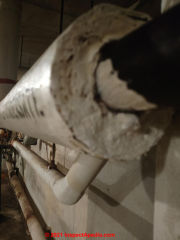
On 2021-04-12 by (mod) - comments on probably constituents of Johan's pipe insulation photos shown below
@Johan,
I see
- painted fabric outer skin
- fiberglass
- what looks like cellulose fragment insulation
None of your photos resemble the classic corrugated paper asbestos pipe insulation nor asbestos paste pipe lagging shown in the article above.
On 2021-04-12 by Johan
Pic of middle portion, where a pipe to the radiator comes out
On 2021-04-12 by Johan
Photos 3 and 4 of the top of the insulation:
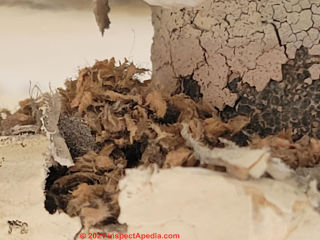 ...
... 
On 2021-04-12 - by (mod) -
@Johan, can you get a sharper photo?
On 2021-04-12 by Johan
Another image at the top of the pipe

On 2021-04-12 by Johan
Hi can you please help me identify what this insulation may contain. It's inside apartment of a building built in 1920s, but insulation probably was installed by a resident later.
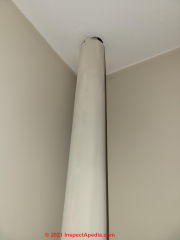
On 2021-02-15 - by (mod) -
Anon:
(and for other readers) If we're talking about the same device, a "Boozy Valve" is a sewer line "backwater valve" that can be closed (automagically or manually) to prevent sewage backup into a building during flood conditions.
I can't guess what's the paper-mache-like clog you found at the Boozy Valve from just text, Anon; whitish or greyish waxy clogs are often grease or organics; Of course anything might have been flushed down a building drain, including newspaper scraps that might end up clogging the boozy valve and looking like paper mache, particularly during the Covid pandemic if folks in a home ran out of toilet paper.
There are not ready sources of asbestos that we'd expect to see at the boozy valve but again anything might have been flushed down a drain;
IF your building has any transite piping used in its drain system, I speculate that if that pipe were damaged it might shed a cemetious debris that might contain asbestos, but I suspect that's not at all likely.
On 2021-02-14 by Anonymous
My home was built in 1950. The basement floor contains a boozy valve to prevent sewage water from entering in the home during a heavy rain storm. Recently, I’ve had backing up in my laundry room due to the basin in the boozy getting full and preventing the flap from opening so the water can exit out through the city sewer line. I used a shop vac to remove the sludge and found a paper mache like material corroded around the flap. Could this be asbestos? Does it ever get into the water line?
On 2021-02-14 - by (mod) -
Ben
Please find your recently-posted question(s) or comments along with our reply now at the Reader Q&A section in the article above on this page. You may need to clear or refresh your browser cache to see the updated page. We welcome your further photos, comments, questions.
On 2021-02-13 by (mod) - asbestos pipe insulation confirmed by lab test
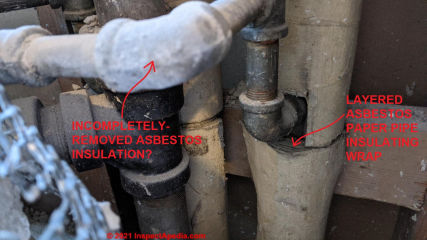 Ben
Ben
Thank you for letting us know the asbestos test results on that asbestos-suspect pipe insulation: that confirmation will help other readers.
On 2021-02-11 by Ben
Lab results came back - sure enough: Pipe wrap (asbestos paper?) Gray Homogeneous 25-50% Chrysotile 10% Cellulose
On 2021-02-10 - by (mod) -
Apologies Anon,
Assessing airborne asbestos hazards from brief text and a photo is just too speculative.
In general you'd expect rather low particle release from intact, undisturbed material.
But
Watch out: though the photo is a bit blurry in that area in particular, I've annotated your image to point out both what I suspect is asbestos insulating pipe wrap and also an area of pipe from which asbestos insulation may have been removed without proper nor thorough cleanup.
If that's the case then you need to beware of possible site contamination by improper and incomplete removal of asbestos insulation.
On 2021-02-10 by Anonymous
Given the state that it is in, do we have a problem if this is a recently opened wall and a breeze was blowing through this cavity and into the basement while he window was open?
On 2021-02-10 - by (mod) -
Pipe
Of course there could be an insulating material with which I'm not familiar but in your photo to me that looks quite a bit like cloth wrapped asbestos paper
On 2021-02-09 by Pipe Wrap Asbestos?
The wrapping here doesn't quite look like the corrugated asbestos show above. Is there any other product it may be?
(The pipe is 1/2 exiting the wrap for scale)
On 2021-02-09 by (mod) - is this pipe insulation asbestos?
Ed:
One of your photos shows yellow fiberglass insulation - for sure;
But at left in that photo is what looks like a thick white paper material - I can't see enough of this to know what it is nor what's beneath it. We cannot rule out asbestos without more investigation.
Depending on what we see if given and "end view" that shows what's under this wrap, we might find that it's an asbestos product or it might be something else not identifiable by image alone - in which case a test for asbestos may then be appropriate.
IN other photos where staples were used, that's not a common fastener found on asbestos pipe insulation.
In another photo (below) we see a white lagging or paste that may be or contain asbestos.

On 2021-02-09 by Ed: do these photos show asbestos pipe insulation?
We had a water leak damage ceiling tiles. Removing the tiles exposed piping that may contain asbestos. Does anything in this picture look like it’s asbestos?
The plaster at the joint of the pipe and the cubby hole materials seem concerning. I have more photos if you would like to see them. I would really appreciate your opinion. Thanks, Ed
...
I was able to add photo so here they are.
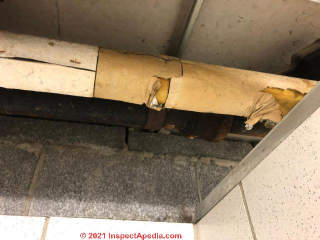 ...
... 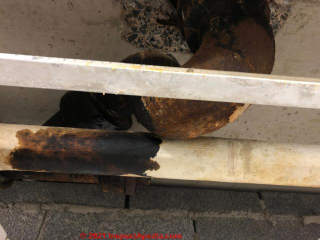
On 2021-01-10 by (mod) - possible wood fibre insulation on piping?
I'm not sure what that material is, Joshua; it looks like a wood fibre material but there is some white material present that's more uncertain;
it is not the typical corrugated asbestos paper pipe insulation;
If by removing or encapsulating loose pipe insulation like that you face a significant expense, then it's worth having samples tested for asbestos, since obviously if no asbestos is detected the procedure is easier and less costly; I'd include both the brown tan (plant-fibre-like) material and the white material I see on the exterior of the wrap and at the right end of the wrap in your photo.
On 2021-01-10 by Joshua
Hello! House was built in the 1920s. This pipe insulation is covering what looks to be the cold water pipe feeding the kitchen and the outdoor spigot.
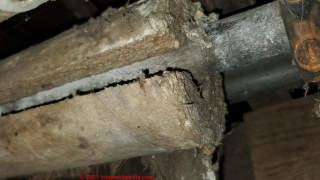
We thought it was asbestos because we didn't know any other type of pipe insulation existed (other than the modern stuff). Are you able to tell if this is asbestos? I can take other photos if needed. Thank you!
On 2020-10-22 by (mod) - corrugated asbestos paper pipe insulation abandoned in crawlspace of home in Belgium
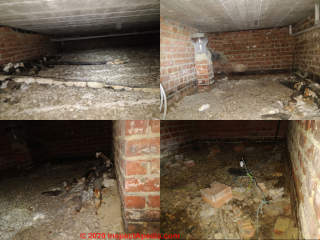 Matt: at least some of that insulation is corrugated asbestos paper pipe insulation such as at upper left in your composite photo.
Matt: at least some of that insulation is corrugated asbestos paper pipe insulation such as at upper left in your composite photo.
Following cleanup of that crawl space you may want to put down 6 mil poly plastic to help keep down moisture and possibly harmful dust and debris;
On 2020-10-21 by Matt
1970 brick house in Belgium. Bought a couple weeks ago and went into the crawl space for a better inspection.
Looks like they left the previous insulation on the heating pipes in a pile in the crawl space. It looks like long white fluffy fibers, almost like silk.
Sorry for the poor quality images, I did not want to get close in case it is asbestos.
On 2020-10-21 - by (mod) -
So sorry Dave but the photo is a bit blurry: I'm not sure what we're seeing. Brown powdery? thick insulation or thin dusty coating on pipe or what?
But to me the ceiling insulation between joists looks like white fiberglass insulation.
See FIBERGLASS INSULATION IDENTIFICATION & PROPERTIES - properties for a key to identifying fiberglass building insulation brands & products.
I see what looks like white foam insulation with some yellow fiberglass around some pipes, and
in the ceiling center of your photo I see what is blurry but looks like foil faced fiberglass and black plastic electrical tape, probably wrapped around a pipe.
On 2020-10-21 by Dave DePo.
My house was built I’m 1961. I removed the last 15’ or so of insulation wrapped on copper water pipe. Photo of refuse is below. It consisted of, from the pipe outward:
Grey plastic with black spiral wrapped electrical tape. Inside the grey plastic was a brown powdery material. Copper from the pipe? Asbestos?
Around the grey plastic was a fiberglass looking insulation, then aluminum foil, then more black electrical tape.
Can you help? I had an N95 mase and goggles and replaced with black foam.
On 2020-10-10 - by (mod) -
The asbestos wrap would have to have been encased in a waterproof, weatherproof container or skin.
On 2020-10-09 by John
Would any kind of asbestos wrap insulation around a pipe survive outdoors exposed to frequent rain for 30 years plus? I haven’t seen any examples of it ever being used in this scenario. Thanks.
On 2020-10-06 - by (mod) -
Rebecca
I can't say if your pipe insulation is asbestos or something else, as I can't see it. Fiberglass pipe insulation as well as asbestos pipe insulation may both be white.
But it's very easy to identify fiberglass pipe insulation by inspecting the end or joints of that material as one can see actual fiberglass.
On 2020-10-06 by Rebecca Walker
Approximately twenty years ago when we purchased our home, we had to have asbestos removed from the crawlspace before a termite inspection was done. We are selling the house now, and our termite inspector says that the insulation on our pipes is asbestos. Is it possible he is mistaking fiberglass insulation for asbestos?
Or assuming that because this is an old house (built 1942) it must be asbestos? I looked at the pipes and they are tightly covered with no holes, rips or tears.
The cover is white. There is no section where the insulation is exposed. I there some way he would know? Something that make asbestos easy to identify? Thanks...
On 2020-09-05 by (mod) - sharp photo of corrugated asbestos paper pipe wrap insulation
that's asbestos pipe insulation;
I'd bag it for disposal. Depending on where you live disposal regulations vary; typically it's disposed-of as construction waste in such small quantities.
On 2020-09-05 by Brad
I found this pipe insulation laying on top of ceiling tiles below a set of steam pipes, in a building constructed around 1906, later renovated in the 1950s.
It looks like air cell.
The remaining insulation still on the pipes looks in good condition, held on with metal bands.
What should I do with the stuff that fell off?
On 2020-08-07 by Nick
Recently I’ve become concerned about possible asbestos in my house and this pipe which comes out of the floor just outside my bedroom that I’ve lived in for 12 years is covered in a white wrap of some kind the house was built in 2004
but I do live in Canada and from what I can gather there was nothing really legally stopping then from putting asbestos in the house as recently as 2016
On 2020-07-10 by (mod)
Mark
The photo's not quite sharp but yes that could be asbestos. Perhaps you can try taking a sharper view of the exposed edge of the insulation
On 2020-07-10 by markcliff
House from 1970's inside a laundry area. Bought an old house think this is asbest is it ?
Price is insane here for asbest removal but expect much cheaper than health.
Help appreciated.
Question: is this asbestos or fiberglass pipe insulation in my building?
 I live in an 18 story building that was built prior to 1968. It is a condo built for rental but later converted to condominiums.
I live in an 18 story building that was built prior to 1968. It is a condo built for rental but later converted to condominiums.
There is currently a plan to replace the cold water piping,currently galvanized pipe and the chilled water lines for A/C
The lines to be replaced are adjacent to the hot water lines that I believe are insulated with asbestos pipe covering (photo attached). All pipes run through a return air plenum in each apartment.
There is no direct return air to the A/C My concern is that the asbestos covering will be disturbed and distributed throughout the apartment via the A/C .
I didn't disturb the insulation or try to take a plug for fear of contaminating my apartment . Does the photo look like asbestos covering ?
Moderator reply: inspect an accessible end of the pipe insulation to see its material
I can't say for sure what you're pipe insulation is without being able to actually see the insulating material. That's sort of plastic fabric looking rapper is often found on the outside of a fiberglass pipe insulation.
If you can find a spot where you can see one of the ends of that rep and you see yellow fiberglass will know the answer to your question. And in case I'm not thrilled with running types with any insulation that may shed inside of an air conditioning or heating duct.
Reader follow-up: confirmed this is fiberglass insulation on the vertical drain pipe
Thanks for your reply. Yes indeed it is fiberglass pipe installation.
I got enough nerve to cut a postage stamp size flap & saw fiberglass.
I duck taped the flap & hope they don't disturb the insulation while doing the pipe replacement. The building is in south Florida so my ac runs 24x7
On 2020-01-07 Faithful Diamond:
Faithful Diamond said:
When i was scrolling through your website, i saw the good works that you have been putting on your website.your articles are so interesting and it is like I have never seen an article like yours, keep on doing the good work that you are putting on your unique website and i will keep on viewing your updates.have a nice day
On 2020-01-06 - by (mod) - photo of classic cloth-wrapped corrugated asbestos paper pipe insulation on a drain pipe
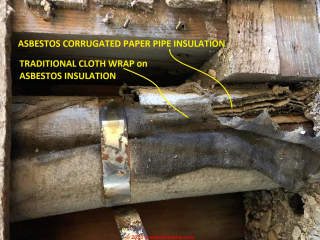 Jay
Jay
To me, sitting here on the other side of the wall in Mexico but trying to help out, that LOOKS like old corrugated asbestos paper pipe insulation wrapped with a fabric and held - not too well - in place with metal strapping.
The insulation looks to be in poor condition.
[Click to enlarge any image]
On 2020-01-06 by Jay B
Is this asbestos, residential house drain for upstairs bath - [Photo above]
On 2019-09-10 - by (mod) - How to determine what asbestos-containing products were brought into or used in what buildings around the entire city of Manhattan
Csryl
How to determine what asbestos-containing products were brought into or used in what buildings around the entire city of Manhattan over a specified time interval of years
What an interesting question, and challenging. I think you would have to find all of the construction records, every bill, receipt, work order, inspection report, for the entire construction period of the building plus all similar reports for maintenance, repairs, renovations, and additions to the building over its lifetime.
Then you'd review those to identify every product that might have contained asbestos, looking beyond product name into specifications and manufacturer identification.
For some of those products the answer will be immediately obvious. Other of those products will need research since not every asbestos-containing product used in a building will necessarily be so-described. For example you might find "ABC Corporation, January 1-9, 1954, install new acoustic ceiling tiles and sound-reduction insulation on the 32nd floor".
In sum I suspect the effort to provide an exhaustive list of every company supplying an asbestos-containing material in a building will be so enormous that you might want to re-consider the actual question you want to answer and to find other approaches. For example medical reports for your husband, interpreted by his doctor(s), might offer an interpretation of whether or not he has or had signs of asbestos-related illness.
And if you're worried that asbestos was brought into your home on clothing, it's putting up "the wall" long after most of the immigrant asbestos has long gone elsewhere, but you could do some dust test screening of your home to at least establish its present condition.
On 2019-09-09 by Csryl
My husband worked in many buildings in Manhattan and other boroughs. How do you find out what asbestos companies supplied which buildings? For example who supplied asbestos for the Woolworth building ....
On 2019-04-20 by (mod) -
One would need to probe and explore the material to see it's actual constituents as it's painted-over; it might be steel wool pushed into an opening to block mice - or something else. More speculation without simply taking a better look is not useful.
On 2019-04-20 by Anonymous
It’s just wat ever leaked from upstairs. But the thing in the corner looks like a Brillo pad gray an white .so what do u think it is ???
On 2019-04-20 by (mod) -
Matthew
What is that dark Jagged line on the insulation in one of your photos? Is that a split? If so shine a light inside. If it's all dark brown and coarse fibrous it's probably a cellulose or mineral wool fiber insulation.
On 2019-04-20 by Anonymous - unknown pipe insulation: asbestos?
Just sent ya two more pictures it’s Matthew
On 2019-04-19 by (mod) - photo of fibrous material, possibly including asbestos
Matthew
It's a nice Sharp Photo but without more context I can't hazard a useful guess about the asbestos makeup of the painted over group in your photo.
It would be helpful to know the age of the building, the age of the material, and just where it has been applied as well as perhaps to see some other photos of undisturbed material of the same sort or in the same location
Don't panic: what we can see is some fibrous material - painted-over. That's not typically what asbestos pipe insulation looks like, but depending on the age, location, and history of the building It may or may not contain asbestos - if so the material may have been encapsulated.
On 2019-04-19 by Matthew
Trying to figure out if this is asbestos
On 2019-03-08 by (mod) -
If the age of the building or pipe insulation puts it before 1985 and it's in North America, combined with the appearance in your photo it makes sense to treat this as an asbestos pipe insulation; you'd either encapsulate it to prevent material release, or have it removed - professionally.
Left un-disturbed the actual release of material into the building air is probably below the limits of detection.
On 2019-03-08 by Mike
I have a pipe wrapped with a cover and some white compound is underneath. Some spots of the insulation are hard while others are soft to the touch. Should I be worried about fibers (if this is asbestos) releasing if the material is soft underneath the cover?
...
Continue reading at ASBESTOS PIPE INSULATION - topic home, or select a topic from the closely-related articles below, or see the complete ARTICLE INDEX.
Or see ASBESTOS PIPE INSULATION FAQs3 - questions and answers posted originally on the topic home page
Or see these
Recommended Articles
- ASBESTOS in GOOD CONDITION
- ASBESTOS in POOR CONDITION
- ASBESTOS REMOVAL, AMATEUR
- ASBESTOS on HEATING BOILERS
- ASBESTOS TESTING LAB LIST
- CEMENT ASBESTOS PIPE MANUFACTURE
Suggested citation for this web page
ASBESTOS PIPE INSULATION FAQs-2 at InspectApedia.com - online encyclopedia of building & environmental inspection, testing, diagnosis, repair, & problem prevention advice.
Or see this
INDEX to RELATED ARTICLES: ARTICLE INDEX to ASBESTOS HAZARDS
Or use the SEARCH BOX found below to Ask a Question or Search InspectApedia
Ask a Question or Search InspectApedia
Try the search box just below, or if you prefer, post a question or comment in the Comments box below and we will respond promptly.
Search the InspectApedia website
Note: appearance of your Comment below may be delayed: if your comment contains an image, photograph, web link, or text that looks to the software as if it might be a web link, your posting will appear after it has been approved by a moderator. Apologies for the delay.
Only one image can be added per comment but you can post as many comments, and therefore images, as you like.
You will not receive a notification when a response to your question has been posted.
Please bookmark this page to make it easy for you to check back for our response.
IF above you see "Comment Form is loading comments..." then COMMENT BOX - countable.ca / bawkbox.com IS NOT WORKING.
In any case you are welcome to send an email directly to us at InspectApedia.com at editor@inspectApedia.com
We'll reply to you directly. Please help us help you by noting, in your email, the URL of the InspectApedia page where you wanted to comment.
Citations & References
In addition to any citations in the article above, a full list is available on request.
- In addition to citations & references found in this article, see the research citations given at the end of the related articles found at our suggested
CONTINUE READING or RECOMMENDED ARTICLES.
- Carson, Dunlop & Associates Ltd., 120 Carlton Street Suite 407, Toronto ON M5A 4K2. Tel: (416) 964-9415 1-800-268-7070 Email: info@carsondunlop.com. Alan Carson is a past president of ASHI, the American Society of Home Inspectors.
Thanks to Alan Carson and Bob Dunlop, for permission for InspectAPedia to use text excerpts from The HOME REFERENCE BOOK - the Encyclopedia of Homes and to use illustrations from The ILLUSTRATED HOME .
Carson Dunlop Associates provides extensive home inspection education and report writing material. In gratitude we provide links to tsome Carson Dunlop Associates products and services.


